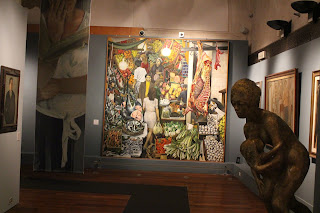On Sunday, June 11th, after another wonderful breakfast, we said goodbye to our hostess and went to the train station, where we ran into her mother, who, after providing us with that feast, was, like us, on her way to Palermo! After a pleasant conversation with her (in Italian, carried on mostly, on our part, by Mary Joy), we caught our train, arriving in Palermo shortly before 11 a.m. We hurried the few blocks to our tour hotel, the Ambasciatori, and checked in, then rushed out, because our only chance to see the Capella Palatina would be before 1 p.m. that day.
We got to the Norman Palace just before they shut down entry, at 12:15. The mosaics in the chapel are spectacular, though not consistent in style or period. Having seen Ravenna, though, I didn’t really have what Rick Steves would call a “wow” moment with anything I saw here or in Monreale the next day. After nearly half an hour in the Capella, we zoomed through the rest of the Palace (much less interesting, except for the one room with Norman mosaics) and got out as it was closing, at 1 p.m., then looked at an exhibition of 20th-century Italian paintings (including one, of Palermo’s Vucciria Market, that we had seen on BBC’s Sicily Unpacked ).
On the way back to the hotel, we stopped for our first Sicilian granitas at a street booth across from the Cathedral. Much nicer than a slushie, though made with shaved ice and flavoring.
At 3 p.m. we went up to the hotel’s rooftop restaurant to meet the other people on our Rick Steves “Best of Sicily in 11 Days” tour. There were 26 of us, besides our guide, Virginia, and her assistant, Giorgio. Virginia is from Abruzzo, but now lives in Seattle, while Giorgio is a native Palermitan. This would be our first Rick Steves tour, though we have been watching his TV shows and using his guidebooks for more than twenty years.
After getting introductions and such out of the way, Virginia took us on an orientation walk, on which we visited the Oratorio of San Lorenzo, with terrific rococo stucco statues and friezes and the copy of a stolen and still-missing painting by Caravaggio. We ended at the Palazzo Federico, where the Austrian-born Countess Federico (and later the count, an avid race-car driver) showed us her husband’s ancestral home—the family derives from Federico, an illegitimate son of the thirteenth-century emperor Frederick II.
Then we went back to the hotel and had a good dinner at the hotel restaurant.









































No comments:
Post a Comment